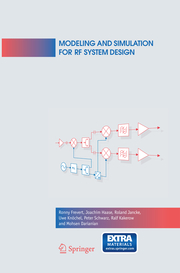-
Zusatztext
-
Modern telecommunication systems are highly complex from an algorithmic point of view. The complexity continues to increase due to advanced modulation schemes, multiple protocols and standards, as well as additional functionality such as personal organizers or navigation aids.To have short and reliable design cycles, efficient verification methods and tools are necessary. Modeling and simulation need to accompany the design steps from the specification to the overall system verification in order to bridge the gaps between system specification, system simulation, and circuit level simulation. Very high carrier frequencies together with long observation periods result in extremely large computation times and requires, therefore, specialized modeling methods and simulation tools on all design levels. The focus of Modeling and Simulation for RF System Design lies on RF specific modeling and simulation methods and the consideration of system and circuit level descriptions. It contains application-oriented training material for RF designers which combines the presentation of a mixed-signal design flow, an introduction into the powerful standardized hardware description languages VHDL-AMS and Verilog-A, and the application of commercially available simulators.Modeling and Simulation for RF System Design is addressed to graduate students and industrial professionals who are engaged in communication system design and want to gain insight into the system structure by own simulation experiences.The authors are experts in design, modeling and simulation of communication systems engaged at the Nokia Research Center (Bochum, Germany) and the Fraunhofer Institute for Integrated Circuits, Branch Lab Design Automation (Dresden, Germany).
-
-
Kurztext
-
Behavioral modeling of communication systemsBridging the gaps between system specification, system simulation, and circuit simulationApplication of modern mixed-signal modeling languages and simulators: VHDL-AMS and Verilog-AOrientation on industrial CAD flowIncludes supplementary material: sn.pub/extras
-
-
Autorenportrait
- InhaltsangabePreface. Acknowledgments. 1 Introduction. 2 Design Flow Overview. 2.1 Design Levels. 2.2 Top-down System Design. 2.3 Bottom-up Verification. 3 Simulation Tools in System Design. 3.1 Use of Simulation Tools within the Design Flow. 3.2 Specific Simulation Algorithms of RF Simulators. 3.3 Criteria of the Simulator Selection. 3.4 Internet Resources for Simulation Tools. 4 System Level Modeling. 4.1 System Level Simulation. 4.2 Simulation Technology of System Level Simulators. 4.3 Complex Baseband Simulation. 4.4 Model Libraries for System Simulation. 4.5 Creation of Own Primitive and Hierarchical Models. 5 VHDLAMS for Block Level Simulation. 5.1 Introduction. 5.2 VHDLAMS Standardization. 5.3 A Simple Block Level Example Analog PLL. 5.4 Summary 6 Introduction to VHDL-AMS. 6.1 Aim of this Introduction. 6.2 Repetition of Basics of VHDL 1076-1993. 6.3 Conservative Systems Description. 6.4 Description of Nonconservative Systems. 6.5 Mixed-Signal Simulation. 6.6 Analysis Domains. 6.7 Summary. 7 Selected RF Blocks in VHDL-AMS. 7.1 Library Overview. 7.2 Signal Sources. 7.3 Basic RF Building Blocks. 7.4 Measurement and Observation Units. 7.5 Block Level Example of a Linear PLL. 8 Macromodeling in VHDL-AMS. 8.1 Introduction. 8.2 General Methodology. 8.3 Input and Output Stages. 8.3.1 Input stages. 8.3.2 Output stages. 8.4 OpAmp Macromodel. 9 Complex Example: WLAN Receiver. 9.1 Introduction. 9.2 Example Specification. 9.3 Example Modeling. 9.4 Example Calibration. 9.5 Example Verification. 10 Modeling of Analog Blocks in Verilog-A. 10.1 Introduction. 10.2 Writing Custom Behavioral Models. 10.3 Overview of the Cadence Model Library rfLib. 10.4 Modeling and Simulation of a WLAN Receiver. 11 Characterization forBottom-Up Verification. 11.1 Concept of Characterization. 11.2 RF Characteristics and Parameters. 11.3 Application of Characterization. 11.4 Example Characterization of an LNA. 11.5 Characterization Environment. 11.6 Characterization Using the OCEAN Script Language. 12 Advanced Methods for Overall System Specification and Validation. 12.1 Gap between System Level and Block Level Simulation. 12.2 File Coupling of Simulators. 12.3 Direct Cosimulation of System Level and Analog Simulators. 12.4 Generated Black Box Models. References. Index.
Detailansicht
Modeling and Simulation for RF System Design
Frevert, Ronny/Haase, Joachim/Jancke, Roland et al
ISBN/EAN: 9781461498322
Umbreit-Nr.: 7552684
Sprache:
Englisch
Umfang: xi, 291 S.
Format in cm:
Einband:
kartoniertes Buch
Erschienen am 16.09.2014
Auflage: 1/2014


